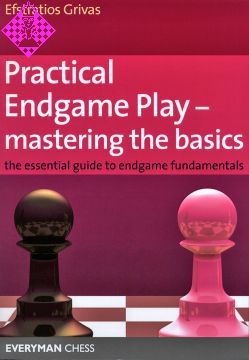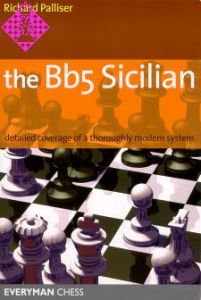Article Number
LEGRIPEP
Author
Practical Endgame Play - Mastering the Basics
320 pages, paperback, Everyman, 1. edition 2008
How can you improve your chess? It' not by chance that grandmasters say 'Study the endgame!' This is because a great number of encounters reach endgames, and studying these positions will teach you how to convert winning positions, and how to save or even overturn inferior ones. Moreover, it's a well known fact that studying endgames undoubtedly enhances your skills in other aspects of the game.
Practical Endgame Play - Mastering the Basics is a comprehensive guide to all fundamental chess endings, and a godsend for those looking to improve their endgame play. Crucially, the emphasis is just as much on practical play as it is on theoretical understanding. Whenever an idea is introduced, Grandmaster Efstratios Grivas immediately illustrates it with a number of entertaining and instructive examples, a considerable number of which are drawn from his own over-the-board experiences.
·All the fundamental endgames are covered
·Full of practical tips and opinions
·Written by an prominent endgame expert
Efstratios Grivas is an experienced Grandmaster from Greece who has represented his country on many occasions, winning an individual gold medal at the 1989 European Team Championship and an individual silver medal at the 1998 Chess Olympiad. He's a Senior FIDE Trainer, a federal trainer for the Greek and Turkish Chess Federations, and also a highly regarded writer with many books and articles to his name.
Introduction
by Sotiris Logothetis
The third World Champion, the Cuban Jose Raul Capablanca, once expressed the opinthat the study of chess should commence with the third and final phase of a chess game: the endgame. The Cuban himself was a renowned master of this stage and his adwas undoubtedly based on his personal experience. Many words have been spoken about the significance of endgame knowledge and experience in practical play there is no point in repeating them here. The book you are holding aims to arm you as well as possifor this phase of the game.
Many people think that the qualities of a grandmaster, compared to an ordinary player, mostly consist of superior opening preparation, greater calculating ability and deeper unof typical middlegame positions. If you, however, take a closer look at games from, say, a strong open tournament, you will notice several cases where the grandmaster outplays a weaker player (or even a fellow grandmaster) in the endgame from more or less an equal position. You are often left wondering how on earth one could lose such a simple position with so few pieces on the board.
And yet, in my personal experience, the last part of the game is where a well educated player can set the opponent the most problems. As the weight of each move increases, any mistake can prove very costly and great accuracy is required. In our times, with the aboliof adjournments and increasingly faster time-controls, endgame knowledge has acgreater significance than ever before.
Many games never reach the endgame. However, every good chessplayer, even in the heat of the battle, must consider the endings that can possibly arise in the course of the game. Our opening moves must take into account the consequences they may impose on a future ending. Doubled, isolated, immobilized or passed pawns, strong and weak squares - in general, all the positional elements, positive or negative, must be considered and evaluated. Anticipation of a favourable ending or fear of an inferior one will often influour decisions in the middlegame, in the sense of selecting or rejecting certain continuations. When dissatisfied with a prospective ending we will often opt for unclear comor serious material or positional concessions. In the end, our evaluation of the endings that may arise will affect the entire course of the battle.
I have known Efstratios for many years and consider myself his student, although not perhaps in the strictest sense of the term. From our endless conversations on chess over the years, I have learned many things about all aspects of the royal game. In recent years I have also had the pleasure of collaborating with him on his writing projects. A pleasure it is indeed, because he takes this work very seriously and tends to be meticulous and very accurate. Having spent countless hours with him, checking and rechecking every single variation and position presented in his books, I can assure you that the writer has worked conscientiously to produce the best possible result.
Efstratios has always been considered an endgame authority, as can be observed by a detailed look at his games. He has possessed a deep and detailed education on the endever since I first met him, which was many years ago. Now he has taken this a step further. The preparation of this book has stretched over several years, during which time Efstratios has delved deeply into existing endgame theory and has discovered and corof course! several important errors. Use has been made of every modern analysis tool (particularly tablebases), in order to get closer to the absolute truth. At the same time, with his usual thoroughness and perfectionism, Efstratios has sought to organize and prethe material in this book without leaving any black holes. I would like to draw your attention particularly to the section on rook endings, arguably the most difficult type of endgame, which can justifiably claim to be the most informative work on the subject ever.
Practical Endgame Play - Mastering the Basics is a comprehensive guide to all fundamental chess endings, and a godsend for those looking to improve their endgame play. Crucially, the emphasis is just as much on practical play as it is on theoretical understanding. Whenever an idea is introduced, Grandmaster Efstratios Grivas immediately illustrates it with a number of entertaining and instructive examples, a considerable number of which are drawn from his own over-the-board experiences.
·All the fundamental endgames are covered
·Full of practical tips and opinions
·Written by an prominent endgame expert
Efstratios Grivas is an experienced Grandmaster from Greece who has represented his country on many occasions, winning an individual gold medal at the 1989 European Team Championship and an individual silver medal at the 1998 Chess Olympiad. He's a Senior FIDE Trainer, a federal trainer for the Greek and Turkish Chess Federations, and also a highly regarded writer with many books and articles to his name.
Introduction
by Sotiris Logothetis
The third World Champion, the Cuban Jose Raul Capablanca, once expressed the opinthat the study of chess should commence with the third and final phase of a chess game: the endgame. The Cuban himself was a renowned master of this stage and his adwas undoubtedly based on his personal experience. Many words have been spoken about the significance of endgame knowledge and experience in practical play there is no point in repeating them here. The book you are holding aims to arm you as well as possifor this phase of the game.
Many people think that the qualities of a grandmaster, compared to an ordinary player, mostly consist of superior opening preparation, greater calculating ability and deeper unof typical middlegame positions. If you, however, take a closer look at games from, say, a strong open tournament, you will notice several cases where the grandmaster outplays a weaker player (or even a fellow grandmaster) in the endgame from more or less an equal position. You are often left wondering how on earth one could lose such a simple position with so few pieces on the board.
And yet, in my personal experience, the last part of the game is where a well educated player can set the opponent the most problems. As the weight of each move increases, any mistake can prove very costly and great accuracy is required. In our times, with the aboliof adjournments and increasingly faster time-controls, endgame knowledge has acgreater significance than ever before.
Many games never reach the endgame. However, every good chessplayer, even in the heat of the battle, must consider the endings that can possibly arise in the course of the game. Our opening moves must take into account the consequences they may impose on a future ending. Doubled, isolated, immobilized or passed pawns, strong and weak squares - in general, all the positional elements, positive or negative, must be considered and evaluated. Anticipation of a favourable ending or fear of an inferior one will often influour decisions in the middlegame, in the sense of selecting or rejecting certain continuations. When dissatisfied with a prospective ending we will often opt for unclear comor serious material or positional concessions. In the end, our evaluation of the endings that may arise will affect the entire course of the battle.
I have known Efstratios for many years and consider myself his student, although not perhaps in the strictest sense of the term. From our endless conversations on chess over the years, I have learned many things about all aspects of the royal game. In recent years I have also had the pleasure of collaborating with him on his writing projects. A pleasure it is indeed, because he takes this work very seriously and tends to be meticulous and very accurate. Having spent countless hours with him, checking and rechecking every single variation and position presented in his books, I can assure you that the writer has worked conscientiously to produce the best possible result.
Efstratios has always been considered an endgame authority, as can be observed by a detailed look at his games. He has possessed a deep and detailed education on the endever since I first met him, which was many years ago. Now he has taken this a step further. The preparation of this book has stretched over several years, during which time Efstratios has delved deeply into existing endgame theory and has discovered and corof course! several important errors. Use has been made of every modern analysis tool (particularly tablebases), in order to get closer to the absolute truth. At the same time, with his usual thoroughness and perfectionism, Efstratios has sought to organize and prethe material in this book without leaving any black holes. I would like to draw your attention particularly to the section on rook endings, arguably the most difficult type of endgame, which can justifiably claim to be the most informative work on the subject ever.
| EAN | 9781857445565 |
|---|---|
| Weight | 620 g |
| Manufacturer | Everyman |
| Width | 17 cm |
| Height | 24.8 cm |
| Medium | Book |
| Year of Publication | 2008 |
| Author | Efstratios Grivas |
| Language | English |
| Edition | 1 |
| ISBN-13 | 9781857445565 |
| Pages | 320 |
| Binding | paperback |
| Name | Everyman (former Cadogan) |
|---|---|
| Adresse | 10 Northburgh Street London EC1V 0AT Großbritannien |
| dcaddelman@yahoo.com |
Verantwortlicher Importeuer:
| Name | Schachversand Niggemann |
|---|---|
| Adresse | Schadowstraße 5 48163 Münster Deutschland |
| info@schachversand.de | |
| Internet | www.schachversand.de |
005 Bibliography & Acknowledgements
007 Foreword by IM Georgios Makropoulos
009 Introduction by Sotiris Logothetis
011 The Golden Rules of the Endgame
Section 1: Pawn Endings
013 Introduction and The Opposition
020 Key Rules
027 Important Techniques
034 Further Practical Examples
Section 2: Rook Endings
040 Introduction and Rook vs. Pawn(s)
050 Rook & Pawn vs. Rook
058 Rook & 2 Pawns vs. Rook
069 Rook & 2 Pawns vs. Rook & Pawn
077 Rook & 3 Pawns vs. Rook & 2 Pawns
083 Rook & 4 Pawns vs. Rook & 3 Pawns on the same wing
094 Rook & 5 Pawns vs. Rook and 4 Pawns
100 Rook & 4 Pawns with a passed a-pawn vs. Rook & 3 Pawns
110 Rook & 4 Pawns with a passed b-pawn vs. Rook & 3 Pawns
118 Rook & 4 Pawns with a passed c-pawn vs. Rook & 3 Pawns
123 Rook & 4 Pawns with a passed d-pawn vs. Rook & 3 Pawns
131 General Rook Endgame Technique
Section 3: Minor Piece Endings
148 Bishop vs. Pawn(s)
154 Same-coloured Bishop Endgames
173 Opposite-coloured Bishop Endgames
179 Knight vs. Pawn(s)
187 Knight Endgames
202 Good Bishop vs. Bad Knight
211 Good Knight vs. Bad Bishop
Section 4: Rook and Minor Piece Endings
223 Rook vs. Bishop
241 Rook vs. Knight
251 Rook & Bishop vs. Rook
257 Rook & Knight vs. Rook
262 Rook vs. Minor Pieces
Section 5: Queen Endings
272 Queen & Pawn Endgames
292 Queen vs. Various Major & Minor Pieces
315 Index of Players
007 Foreword by IM Georgios Makropoulos
009 Introduction by Sotiris Logothetis
011 The Golden Rules of the Endgame
Section 1: Pawn Endings
013 Introduction and The Opposition
020 Key Rules
027 Important Techniques
034 Further Practical Examples
Section 2: Rook Endings
040 Introduction and Rook vs. Pawn(s)
050 Rook & Pawn vs. Rook
058 Rook & 2 Pawns vs. Rook
069 Rook & 2 Pawns vs. Rook & Pawn
077 Rook & 3 Pawns vs. Rook & 2 Pawns
083 Rook & 4 Pawns vs. Rook & 3 Pawns on the same wing
094 Rook & 5 Pawns vs. Rook and 4 Pawns
100 Rook & 4 Pawns with a passed a-pawn vs. Rook & 3 Pawns
110 Rook & 4 Pawns with a passed b-pawn vs. Rook & 3 Pawns
118 Rook & 4 Pawns with a passed c-pawn vs. Rook & 3 Pawns
123 Rook & 4 Pawns with a passed d-pawn vs. Rook & 3 Pawns
131 General Rook Endgame Technique
Section 3: Minor Piece Endings
148 Bishop vs. Pawn(s)
154 Same-coloured Bishop Endgames
173 Opposite-coloured Bishop Endgames
179 Knight vs. Pawn(s)
187 Knight Endgames
202 Good Bishop vs. Bad Knight
211 Good Knight vs. Bad Bishop
Section 4: Rook and Minor Piece Endings
223 Rook vs. Bishop
241 Rook vs. Knight
251 Rook & Bishop vs. Rook
257 Rook & Knight vs. Rook
262 Rook vs. Minor Pieces
Section 5: Queen Endings
272 Queen & Pawn Endgames
292 Queen vs. Various Major & Minor Pieces
315 Index of Players
Der griechische GM, der mittlerweile eine Vielzahl an Büchern publiziert hat, ist leider auch ein Großmeister der Selbstdarstellung. Schon die Bibliographie, die ungewöhnlicherweise am Anfang des Buches direkt nach der Inhaltsangabe steht, führt etliche seiner Bücher auf, obgleich sie überhaupt nichts mit dem Endspiel zu tun haben; andererseits fehlen wichtige Publikationen von Autoren wie Awerbach, Dworetski oder Müller. Auch kann der Behauptung in der kurzen Einführung nicht zugestimmt werden, der Teil über das Turmendspiel sei „the most informative work on the subject ever” - eine maßlose Übertreibung.
Darüber hinaus neigt Grivas wie kaum ein anderer in seinen Büchern dazu, auf eigene Beispiele zurückzugreifen. Das mag Vorteile haben, weil der Autor mit den Stellungen vertraut ist. Manchmal packt den Leser aber Zweifel, ob es nicht bessere Exempel gegeben hätte, insbesondere weil es sich zumeist um Siege von Grivas handelt. Eine penetrante Selbstinszenierung, mit der der Autor schon seit geraumer Zeit an seinem Vermächtnis schreibt.
Sieht man über diese Unannehmlichkeiten hinweg, ist Grivas Werk inhaltlich nicht ganz so schlecht. Seine Kommentare sind kritisch, die wichtigsten Punkte werden in Merksätzen (basic guidelines) zusammengefasst. Die einzelnen Themen sind allerdings oft nur kurz angerissen. Besonders frappant wird dies bei den ungleichen Läufern, wo Grivas lediglich sechs Seiten verwendet, die bei weitem nicht alle zur Verfügung stehenden Techniken aufzeigen. Der Autor leistet sich sogar den erstaunlichen Verzicht auf die berühmte Partie zwischen Topalow und Schirow.
Practical Endgame Play leistet dennoch brauchbare Dienste, um sich in die Materie einzuarbeiten.
Mit freundlicher Genehmigung
Harry Schaack, KARL 2/2008**********
Eine erfreuliche Überraschung ist das Enddes griechiGM Grivas. Nach drei teuren und Bände seines „Chess College" und einem mittelmäßigen Strategieist ihm nun endlich ein ansehnund vor allem preiswertes Buch gelungen. In 5 Hauptabschnitmit insgesamt 31 Kapiteln deckt Grivas den gesamten Endspielbeab, gegliedert in Pawn Endings, Rook Endings, Minor Piece Endings, Rook and Minor Piece Endings, Queen Endings.
Die Einführungen zu den einzelnen Kapiteln sind wieder grivastypisch extrem kurz gehalten - kaum mehr als eine Seite für die Hauptabschnitoft nur wenige Zeilen für die KaZwar sind weitere Erklärungen zwar in die jeweiligen Endspiele eingebettet, doch ist diese Form für Leser, die nach Grundlagenwissen, Merkregeln und einem festen Grundgerüst streben, weniger zuänglich. So ist das Buch weniger für schwächere bzw. wenig Endspiel erfahrene Spieler geeignet. Für diese empfiehlt sich eher Silmans Endder mehr auf die Grundlaeingeht und zusätzliche Übungsbeinhaltet. Auch das deutschsprachige Endspielbuch von Bemd Rosen wäre eine gute AlterWer jedoch schon die Grundeinigermaßen beherrscht und/oder über eine gehobene Spielverfügt, hat mit dem Grivas Buch eine sehr gut geratene Sammvon Endspielen zur Hand.
Ein gut gemachtes, übersichtlich layoutetes Buch mit einer großen Anzahl von Endspielen, das sich für Spieler ab mittlerer Klubstärke mit Endspiel-Vorkenntnissen oder sonst für starke Klubspieler als Trainingsgut eignet. Für ein großforBuch von 320 S. ist 22,95 € eher als Schnäppchenpreis zu sehen.
Mit freundlicher Genehmigung
Heinz Brunthaler, Rochade Europa 6/2008**********
Der griechische Großmeister Efstratios Grivas legt mit Practical Endgame Play - Mastering the Basics ein Endspielbuch vor, daß sich selbst als Ergänzung zu Glenn Flears Practical Endgame Play - beyond the basics (Everyman, 2007) sieht. Während im ersten Band grundlegende Techniken erläutert wurden, setzt das Werk von Grivas mehr auf das praktische Spiel. Der Autor untersucht sämtliche praxisrelevanten Endspiele und bringt dementsprechend viele Beispiele aus Großmeisterpartien. Der Autor beginnt sein Buch mit den einfachsten Bauernendspielen, geht dann über zu den Turmendspielen um in den abschließenden Kapiteln die gemischten Endspiele und die Damenendspiele zu behandeln.
Zu jedem Thema gibt es mehrere Beispiele aus der Turnierpraxis wobei Grivas bevorzugt Partien von den bekannteren Spielern verwendet hat. Die Erläuterungen sind sachlich und auf den Punkt gebracht, vor jeder neuen Lektion bringt Grivas eine kleine Einleitung um seine Leser einzustimmen.
Im Bereich der Bauernendspiele geht Grivas noch einmal auf die wichtigsten Oppositionsregeln ein und zeigt anhand von Partiefragmenten, wie Großmeister in der Praxis solche Dinge wie kritische Felder, Gegenfelder und die berühmt berüchtigten korrelierenden Felder behandeln. Im letzteren Fall waren mir die Erklärungen dazu etwas zu dünn, hier hätte man ruhig etwas mehr ausholen können, im Großen und Ganzen aber okay.
Bei den Turmendspielen gibt es zur Wiederholung die elementaren Stellungen die jeder eigentlich kennen müsste: Lucena-Stellung, Phillidor-Stellung, usw. Anschließend zeigen Capablanca, Karpow und Co., welchen Stellenwert die Kenntnis solcher Stellungen in der Praxis hat. Auch bei den restlichen Endspielen wird so verfahren, erst ein paar einfache Basics und anschließend Beispiele aus der Praxis.
Vielleicht hätten dem Buch ein paar ausgewählte Teststellungen ganz gut getan, der Leser hätte hier (wie in vergleichbaren Werken) sein Wissen auf die Probe stellen können um zu überprüfen, ob er das gelesene auch in die Praxis umsetzen kann!?
Wie dem auch sei, der Autor hat eine solide und zufrieden stellende Arbeit abgeliefert, nicht mehr und nicht weniger. Ich glaube persönlich, dass es das Buch nicht ganz einfach haben wird da es bereits sehr viele gute Endspielbücher auf dem Markt gibt und sich dieses nicht besonders davon abhebt. Trotzdem kann ich das Buch ruhigen Gewissens empfehlen um seine Endspielkenntnisse zu verbessern oder aufzufrischen, gute Englischkenntnisse vorausgesetzt.
Mit freundlicher Genehmigung
Martin Rieger, www.freechess.info
Darüber hinaus neigt Grivas wie kaum ein anderer in seinen Büchern dazu, auf eigene Beispiele zurückzugreifen. Das mag Vorteile haben, weil der Autor mit den Stellungen vertraut ist. Manchmal packt den Leser aber Zweifel, ob es nicht bessere Exempel gegeben hätte, insbesondere weil es sich zumeist um Siege von Grivas handelt. Eine penetrante Selbstinszenierung, mit der der Autor schon seit geraumer Zeit an seinem Vermächtnis schreibt.
Sieht man über diese Unannehmlichkeiten hinweg, ist Grivas Werk inhaltlich nicht ganz so schlecht. Seine Kommentare sind kritisch, die wichtigsten Punkte werden in Merksätzen (basic guidelines) zusammengefasst. Die einzelnen Themen sind allerdings oft nur kurz angerissen. Besonders frappant wird dies bei den ungleichen Läufern, wo Grivas lediglich sechs Seiten verwendet, die bei weitem nicht alle zur Verfügung stehenden Techniken aufzeigen. Der Autor leistet sich sogar den erstaunlichen Verzicht auf die berühmte Partie zwischen Topalow und Schirow.
Practical Endgame Play leistet dennoch brauchbare Dienste, um sich in die Materie einzuarbeiten.
Mit freundlicher Genehmigung
Harry Schaack, KARL 2/2008**********
Eine erfreuliche Überraschung ist das Enddes griechiGM Grivas. Nach drei teuren und Bände seines „Chess College" und einem mittelmäßigen Strategieist ihm nun endlich ein ansehnund vor allem preiswertes Buch gelungen. In 5 Hauptabschnitmit insgesamt 31 Kapiteln deckt Grivas den gesamten Endspielbeab, gegliedert in Pawn Endings, Rook Endings, Minor Piece Endings, Rook and Minor Piece Endings, Queen Endings.
Die Einführungen zu den einzelnen Kapiteln sind wieder grivastypisch extrem kurz gehalten - kaum mehr als eine Seite für die Hauptabschnitoft nur wenige Zeilen für die KaZwar sind weitere Erklärungen zwar in die jeweiligen Endspiele eingebettet, doch ist diese Form für Leser, die nach Grundlagenwissen, Merkregeln und einem festen Grundgerüst streben, weniger zuänglich. So ist das Buch weniger für schwächere bzw. wenig Endspiel erfahrene Spieler geeignet. Für diese empfiehlt sich eher Silmans Endder mehr auf die Grundlaeingeht und zusätzliche Übungsbeinhaltet. Auch das deutschsprachige Endspielbuch von Bemd Rosen wäre eine gute AlterWer jedoch schon die Grundeinigermaßen beherrscht und/oder über eine gehobene Spielverfügt, hat mit dem Grivas Buch eine sehr gut geratene Sammvon Endspielen zur Hand.
Ein gut gemachtes, übersichtlich layoutetes Buch mit einer großen Anzahl von Endspielen, das sich für Spieler ab mittlerer Klubstärke mit Endspiel-Vorkenntnissen oder sonst für starke Klubspieler als Trainingsgut eignet. Für ein großforBuch von 320 S. ist 22,95 € eher als Schnäppchenpreis zu sehen.
Mit freundlicher Genehmigung
Heinz Brunthaler, Rochade Europa 6/2008**********
Der griechische Großmeister Efstratios Grivas legt mit Practical Endgame Play - Mastering the Basics ein Endspielbuch vor, daß sich selbst als Ergänzung zu Glenn Flears Practical Endgame Play - beyond the basics (Everyman, 2007) sieht. Während im ersten Band grundlegende Techniken erläutert wurden, setzt das Werk von Grivas mehr auf das praktische Spiel. Der Autor untersucht sämtliche praxisrelevanten Endspiele und bringt dementsprechend viele Beispiele aus Großmeisterpartien. Der Autor beginnt sein Buch mit den einfachsten Bauernendspielen, geht dann über zu den Turmendspielen um in den abschließenden Kapiteln die gemischten Endspiele und die Damenendspiele zu behandeln.
Zu jedem Thema gibt es mehrere Beispiele aus der Turnierpraxis wobei Grivas bevorzugt Partien von den bekannteren Spielern verwendet hat. Die Erläuterungen sind sachlich und auf den Punkt gebracht, vor jeder neuen Lektion bringt Grivas eine kleine Einleitung um seine Leser einzustimmen.
Im Bereich der Bauernendspiele geht Grivas noch einmal auf die wichtigsten Oppositionsregeln ein und zeigt anhand von Partiefragmenten, wie Großmeister in der Praxis solche Dinge wie kritische Felder, Gegenfelder und die berühmt berüchtigten korrelierenden Felder behandeln. Im letzteren Fall waren mir die Erklärungen dazu etwas zu dünn, hier hätte man ruhig etwas mehr ausholen können, im Großen und Ganzen aber okay.
Bei den Turmendspielen gibt es zur Wiederholung die elementaren Stellungen die jeder eigentlich kennen müsste: Lucena-Stellung, Phillidor-Stellung, usw. Anschließend zeigen Capablanca, Karpow und Co., welchen Stellenwert die Kenntnis solcher Stellungen in der Praxis hat. Auch bei den restlichen Endspielen wird so verfahren, erst ein paar einfache Basics und anschließend Beispiele aus der Praxis.
Vielleicht hätten dem Buch ein paar ausgewählte Teststellungen ganz gut getan, der Leser hätte hier (wie in vergleichbaren Werken) sein Wissen auf die Probe stellen können um zu überprüfen, ob er das gelesene auch in die Praxis umsetzen kann!?
Wie dem auch sei, der Autor hat eine solide und zufrieden stellende Arbeit abgeliefert, nicht mehr und nicht weniger. Ich glaube persönlich, dass es das Buch nicht ganz einfach haben wird da es bereits sehr viele gute Endspielbücher auf dem Markt gibt und sich dieses nicht besonders davon abhebt. Trotzdem kann ich das Buch ruhigen Gewissens empfehlen um seine Endspielkenntnisse zu verbessern oder aufzufrischen, gute Englischkenntnisse vorausgesetzt.
Mit freundlicher Genehmigung
Martin Rieger, www.freechess.info
More from Everyman
-
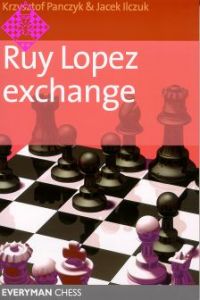 Ruy Lopez Exchange€18.95
Ruy Lopez Exchange€18.95 -
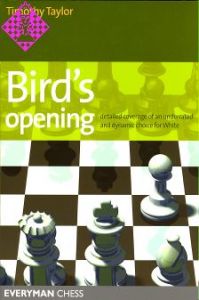 Bird's Opening€18.50
Bird's Opening€18.50 -
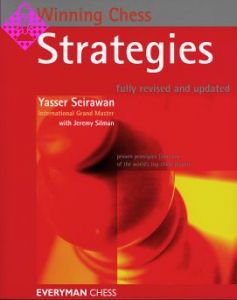 Winning Chess Strategies€19.50
Winning Chess Strategies€19.50 -
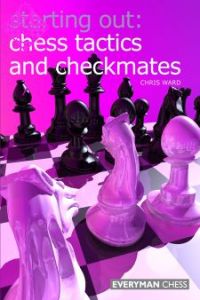 Chess Tactics and Checkmates€18.95
Chess Tactics and Checkmates€18.95 -
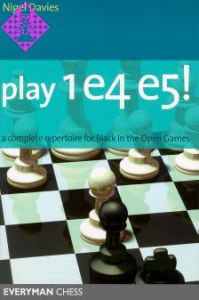 Play 1.e4 e5!€20.95
Play 1.e4 e5!€20.95 -
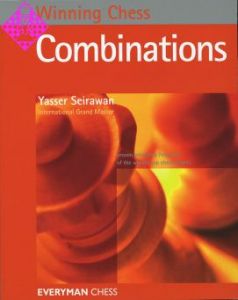 Winning Chess Combinations€21.50
Winning Chess Combinations€21.50 - More from Everyman

